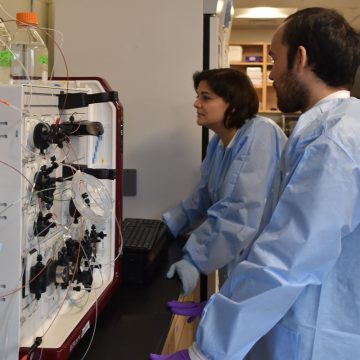Researchers at Dartmouth’s Geisel School of Medicine have received a $12.5 million renewal grant from the National Institutes of Health (NIH) to continue the groundbreaking work of the Institute for Biomolecular Targeting at Dartmouth, also known as bioMT.
The bioMT project is funded as an Institutional Development Award (IDeA) Center for Biomedical Research Excellence (COBRE) from the NIH’s National Institute of General Medical Sciences. The IDeA program builds research capacity in states that historically have had low levels of NIH funding—by supporting basic, clinical, and translational research; faculty development; and infrastructure improvements.

“The COBRE grants provide support in three 5-year phases, which can be thought of as ‘building, strengthening, and transitioning’ stages in funding,” explains Dean Madden, PhD, a professor of biochemistry and cell biology at Geisel, who serves as director of bioMT and principal investigator of the COBRE grant, as well as the vice provost for research at Dartmouth. “Success at each phase helps to ensure continued support in the next, with the long-term goal of centers becoming fully self-supporting.”
Established with phase one funding in 2016, bioMT was created to cultivate studies at the interface of fundamental biology and translational science to develop pre-clinical targets for drug development in diseases like cancer, cystic fibrosis, and viral infections. “The idea is that studying diseases and basic biological processes aren’t separate undertakings—each informs the other,” he says.
During phase one, Madden and his colleagues worked to meet objectives in several key areas to ensure early success of the program. One was to recruit and support the work of junior investigators who could lead targeted projects with the help of seasoned mentoring teams.
“A big part of that was to accelerate the launch of junior faculty laboratories,” says Madden, who also directs the Dartmouth Cystic Fibrosis Research Center at Geisel. “The idea was for them to get lots of data to work with and studies to publish, to help them get sizable grants so they could become independent in about three years. When they ‘graduated,’ we could then hire new junior investigators to take their slots and repeat the process. At the same time, we sought to recruit existing faculty from across Dartmouth who were excited about the vision of the center.”
Another major goal was to create dedicated core facilities with advanced tools and resources that could be shared amongst all members of the program—equipment and staff that are typically too expensive for individual labs to purchase and maintain on their own.

Thus far, the program has performed exceptionally well. In phase one, all six research project leaders with at least two years’ support already earned major funding (R01-equivalent) awards as principal investigators, for a total of $18.8 million. With the help of investors, one launched a $50 million start up. All who were eligible were promoted, and collectively the group gave 116 scientific presentations and published 100 manuscripts—30 in top-tier journals.
“We also helped hire 10 faculty members and built from scratch Molecular Tools and Molecular Interactions and Imaging Cores that are now shared by more than 60 investigators across Dartmouth,” says Madden. “And our interdisciplinary seminars and workshops, which have helped us develop a real sense of intellectual community, have forged a bioMT identity that spans 10 departments across three schools—Geisel, Arts and Sciences, and Thayer School of Engineering.”
In phase two, Madden and his colleagues will be focused on meeting three main aims. “The first involves continuing to recruit junior faculty while increasing our cohort of funded bioMT investigators, so we can fill strategic roles in our research landscape,” Madden says, noting that initial projects will focus on viral immunity, melanoma immunotherapy, and cancer progression.
A second aim will be to expand on core offerings (based on gaps identified in surveys with center members)—to include parallel protein expression, advanced microscopy, and cryoEM technologies, with a special emphasis placed on providing additional support for mass spectrometry experiments on campus.
And they will continue to organize the program’s seminars and regional symposia—to enrich connections within the bioMT program while enhancing the diversity and inclusiveness of its scientific community. Madden hopes that these strategies will position the program for a successful transition into phase three support and ultimate COBRE independence.
When asked what stands out most about bioMT’s early success, he says, “For me, it’s watching our junior faculty just take off and thrive in their careers, which they all have done spectacularly. And we can see already the impact of the projects that we started.
“That’s one of the really great things about this funding mechanism—it allows our investigators to expand the reach and impact of their research in ways that just wouldn’t be possible without the resources and support from the COBRE.”